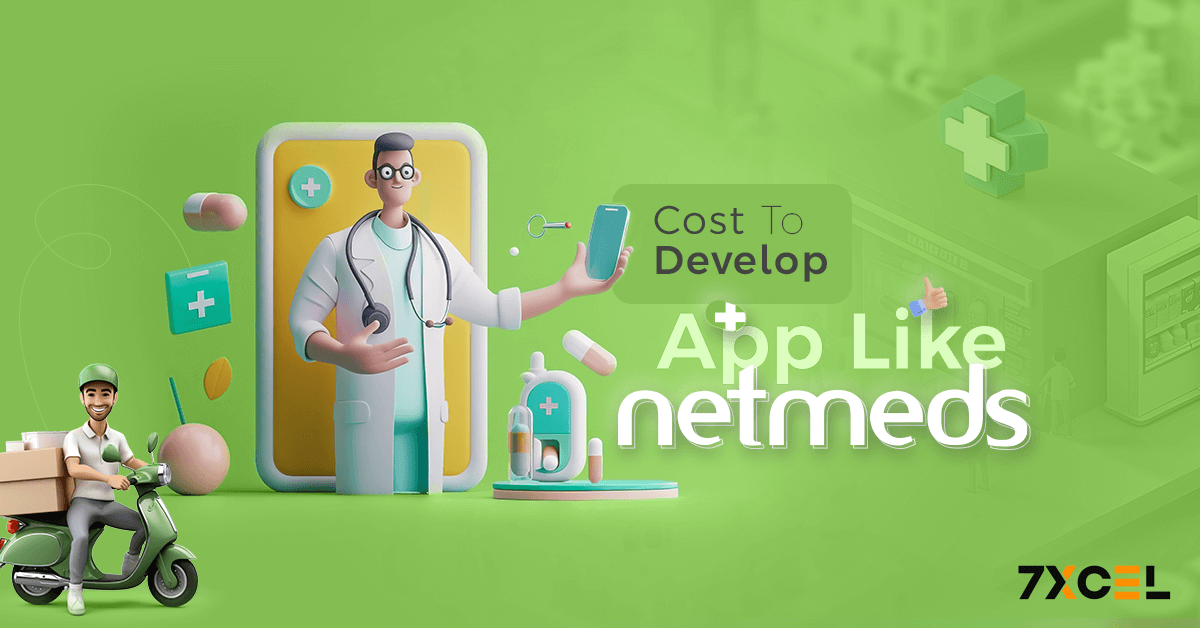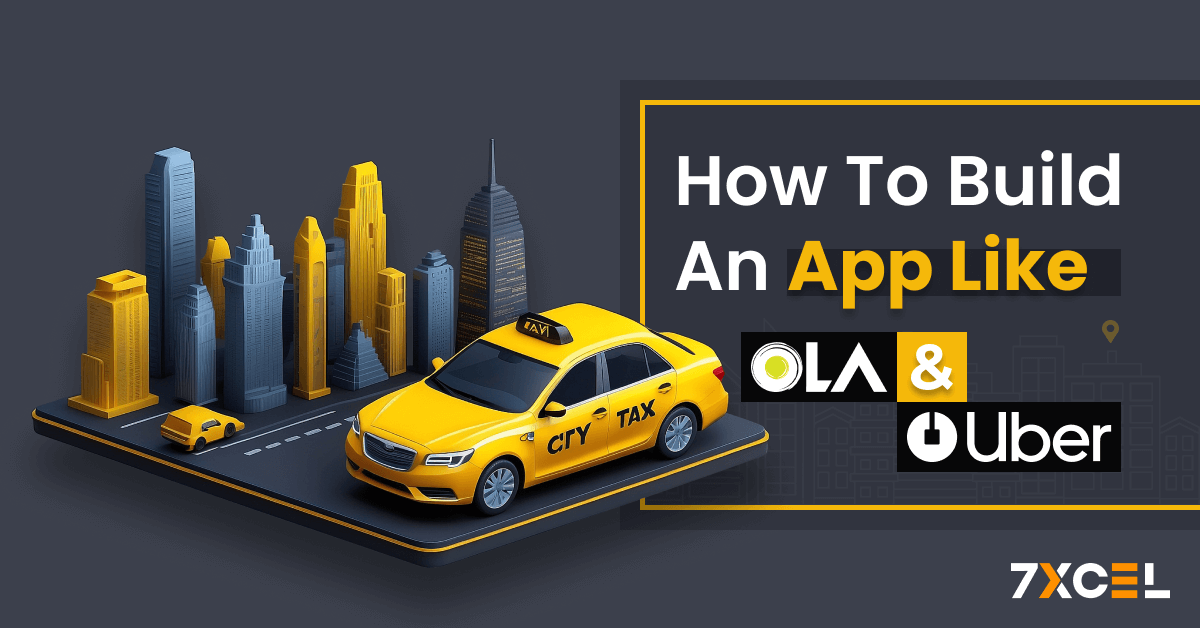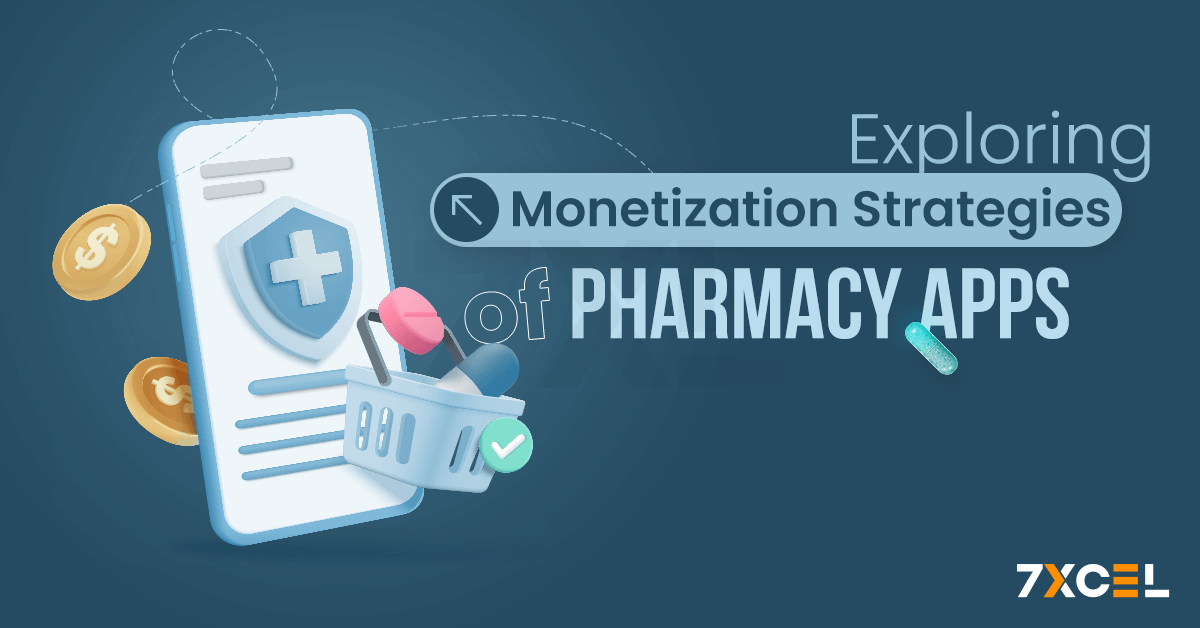Quick Summary:
The rise of online medicine delivery apps like NetMeds has transformed the healthcare industry. These apps offer the convenience of ordering medicines online, consulting with healthcare professionals, and accessing health-related content—all from the comfort of one’s home. But what does it take to build an app like NetMeds? This blog post shed the light into the current market stats, must-have features, cost estimations, and tips to reduce development costs for a medicine delivery app.
In this blog, we’re going to discuss📝
- Market Stats on Medicine Delivery Industry
- Features of an Online Medicine Delivery App
- How Much Does It Cost to Build a Medicine Delivery App Like NetMeds?
- Factors Affecting the Cost of Building a Medicine Delivery App like NetMeds
- Ways to Reduce the Cost of Building a Medicine Delivery App Like NetMeds
- How Can 7xcel Help You Build a Medicine Delivery App Like NetMeds?
The healthcare industry has witnessed a remarkable shift towards digital solutions, with online medicine delivery apps like NetMeds transforming the way people access essential medications. These apps provide convenience, accessibility, and efficiency, making it easier for users to order and receive medicines from the comfort of their homes.
Here, we will analyze the current market statistics of the medicine delivery industry, the must-have features of an online medicine delivery app, the cost involved in developing an app like NetMeds, and strategies to reduce development costs. Additionally, we will guide you on how to build a medicine delivery app and explain how 7xcel can assist you in creating a successful app like NetMeds.
Current Market Stats on Medicine Delivery Industry
The online medicine delivery industry is experiencing rapid growth due to increasing consumer demand for convenience and accessibility. Here are some key statistics highlighting the industry’s current state:
- Market Size: As per the report, the global online pharmacy market was valued at approximately US $52.51bn by 2024 and is projected to reach US $81.37bn by 2028, growing at a compound annual growth rate (CAGR) of 17.3% from 2021 to 2028.
- User Base: In 2021, over 40% of consumers in the U.S. reported using online pharmacies, a trend driven by the COVID-19 pandemic and a growing preference for contactless services.
- Revenue Growth: The revenue of online pharmacies is expected to surpass $200 billion by 2026, driven by increasing internet penetration, smartphone adoption, and a rise in chronic diseases that require regular medication.
- Market Drivers: Key drivers include the aging population, rising healthcare costs, technological advancements in e-commerce, and the increasing frequency of chronic diseases that require long-term medication.
These statistics underscore the significant potential for growth in the online medicine delivery market, making it an opportune time to invest in developing a medicine delivery app.
Must-Have Features of an Online Medicine Delivery App
To ensure the success of your medicine delivery app, it is crucial to incorporate essential features that enhance user experience and streamline operations. Below is a detailed breakdown of the must-have functionalities for a medicine delivery app, along with the estimated costs for each feature:

1. User Registration
A user-friendly and secure registration process is vital for attracting and retaining users. This can be facilitated through multiple authentication methods, including email, social media, or phone number verification.
Key Features:
- Email and Password: Standard registration method using email and password.
- Social Media Login: Quick login using social media accounts like Facebook or Google.
- Phone Number Authentication: Verification via OTP for secure access.
- Profile Management: Users can update personal information and preferences.
Estimated Cost: $1,500 – $3,000
2. Medicine Search
Allow users to search for medicines quickly and efficiently. The search functionality should include various filters such as brand, category, and price to help users find the products they need.
Key Features:
- Search Bar: Quick search with auto-suggestions for medicines.
- Filters: Options to filter by category, brand, price, and availability.
- Sorting: Sort by relevance, price, popularity, and ratings.
Estimated Cost: $2,000 – $4,000
3. Expert Counseling
Incorporate a feature for users to consult with medical experts for advice on medication and health issues. This can be a chat-based or video consultation service that provides personalized medical guidance.
Key Features:
- Consultation Booking: Schedule appointments with medical experts.
- Live Chat or Video Calls: Real-time communication with healthcare professionals.
- Medical Records Access: Access to user’s medical history during consultations.
Estimated Cost: $3,000 – $5,000
4. Trending Fitness Meals
Provide users with information on trending fitness meals and health tips to promote a holistic approach to wellness. This feature can include recipes, dietary advice, and links to related products.
Key Features:
- Daily Tips: Regular updates on fitness meals and health tips.
- Recipe Recommendations: Suggestions for healthy recipes and meal plans.
- Related Products: Links to purchase related health products and supplements.
Estimated Cost: $2,000 – $3,500
5. My Order Section
Enable users to view their order history, track current orders, and repeat previous orders with ease. This section provides a comprehensive view of past and ongoing transactions.
Key Features:
- Order History: Detailed history of all past orders.
- Order Tracking: Allow real-time updates on the status of current orders.
- Reorder Functionality: Option to quickly reorder previous purchases.
Estimated Cost: $2,500 – $4,500
6. Track Order
Real-time order tracking provides transparency and enhances the user experience. Users can view the delivery status and estimated arrival time of their orders.
Key Features:
- GPS Tracking: Real-time location tracking of the delivery.
- Status Updates: Notifications for order status changes.
- Estimated Delivery Time: Provides accurate delivery time predictions.
Estimated Cost: $2,500 – $5,000
7. Return Policy
A clear and customer-friendly return policy builds trust and ensures customer satisfaction. This feature allows users to return products easily and provides information on return conditions.
Key Features:
- Return Requests: Submit and track return requests for orders.
- Return Conditions: Detailed information on the return policy and eligible items.
- Refund Processing: Options for refunds or exchanges.
Estimated Cost: $1,500 – $3,000
8. Loyalty Points
Reward the customers with loyalty points that can be saved for discounts on future purchases. This feature encourages repeat business and enhances customer loyalty.
Key Features:
- Points Accumulation: Earn points on each purchase.
- Redemption Options: Redeem points for discounts or rewards.
- Loyalty Tiers: Different levels of loyalty with varying rewards.
Estimated Cost: $2,000 – $4,000
9. Managing Information
Allow users to manage their personal information, including contact details and addresses. This feature provides users with control over their profiles and ensures their information is up-to-date.
Key Features:
- Profile Editing: Update personal details like name, email, and phone number.
- Address Management: Add, edit, and delete delivery addresses.
- Preferences: Manage communication preferences and notification settings.
Estimated Cost: $1,500 – $3,000
10. Ratings and Reviews
Enable users to rate and review products and services. This feature fosters community trust and provides valuable feedback for continuous improvement.
Key Features:
- Product Ratings: Users can rate products based on their experience.
- Review Submission: Write and submit detailed reviews.
- Review Management: Admins can respond to and manage user reviews.
Estimated Cost: $1,500 – $3,000
11. Delivery and Shipment
Provide multiple delivery options, including express delivery and standard shipping, with clear pricing and timelines. This feature enhances flexibility and user satisfaction.
Key Features:
- Delivery Options: Choose from express, standard, or scheduled deliveries.
- Pricing Details: Transparent pricing for each delivery option.
- Delivery Tracking: Track the delivery status and estimated arrival time.
Estimated Cost: $2,500 – $5,000
12. Discount Management
Offer discounts and promotional codes to attract and retain customers. This feature helps in the creation and management of various discount offers.
Key Features:
- Promo Codes: Create and distribute promotional codes for discounts.
- Discount Rules: Set rules and conditions for discount eligibility.
- Analytics: Track the performance of discount campaigns.
Estimated Cost: $2,000 – $4,000
13. Managing Products
Admin features for adding, updating, and removing products ensure the app remains up-to-date with current inventory and pricing.
Key Features:
- Product Catalog: Manage the product catalog with categories and detailed descriptions.
- Inventory Management: Track stock levels and update availability.
- Price Management: Update and manage product pricing and promotions.
Estimated Cost: $3,000 – $6,000
14. Affiliate Marketing
Incorporate affiliate marketing features to promote products and services through partner networks. This can expand your reach & boost sales through third-party referrals.
Key Features:
- Affiliate Program Setup: Create and manage affiliate partnerships.
- Tracking Links: Generate tracking links for affiliates to use.
- Commission Management: Track sales and calculate affiliate commissions.
Estimated Cost: $2,000 – $4,000
15. Refined Search
Advanced search functionalities, including voice search and predictive text, enhance usability and improve the user experience by making it easier to find products.
Key Features:
- Voice Search: This feature helps the users to look for products using voice commands.
- Predictive Text: Auto-suggestions based on user input and search history.
- Advanced Filters: Refined filters for more specific search results.
Estimated Cost: $2,500 – $5,000
16. Upload Prescriptions
Allow users to upload prescriptions directly for verification, ensuring compliance with medical regulations. This feature streamlines the ordering process for prescription-based medicines.
Key Features:
- Prescription Upload: Upload via camera, gallery, or document upload.
- Verification: Secure verification process for prescription validation.
- Storage: Safe storage of prescriptions for future reference.
Estimated Cost: $1,800 – $3,500
17. Associate Medical Store
Feature partnerships with local medical stores to expand the range of available products and ensure quick deliveries. This feature allows users to shop from various affiliated stores.
Key Features:
- Store Partnerships: Integration with local medical stores.
- Product Availability: Display products available at partner stores.
- Delivery Options: Options for local delivery from associated stores.
Estimated Cost: $3,000 – $6,000
Summary Table of Features and Their Estimated Costs
| Feature | Overview | Estimated Cost |
| User Registration | Secure registration via email, social media, or phone number | $1,500 – $3,000 |
| Medicine Search | Advanced search with filters and sorting | $2,000 – $4,000 |
| Expert Counseling | Consultations with medical experts via chat or video | $3,000 – $5,000 |
| Trending Fitness Meals | Information on fitness meals and health tips | $2,000 – $3,500 |
| My Order Section | View order history, track orders, and reorder | $2,500 – $4,500 |
| Track Order | Real-time order tracking with GPS | $2,500 – $5,000 |
| Return Policy | Manage return requests and provide refund options | $1,500 – $3,000 |
| Loyalty Points | Reward points for customer loyalty and repeat purchases | $2,000 – $4,000 |
| Managing Information | Update personal details and addresses | $1,500 – $3,000 |
| Ratings and Reviews | User feedback on products and services | $1,500 – $3,000 |
| Delivery and Shipment | Multiple delivery options and tracking | $2,500 – $5,000 |
| Discount Management | Create and manage discounts and promo codes | $2,000 – $4,000 |
| Managing Products | Admin control for product updates and inventory management | $3,000 – $6,000 |
| Affiliate Marketing | Promote products through affiliate partnerships | $2,000 – $4,000 |
| Refined Search | Advanced search features including voice search and predictive text | $2,500 – $5,000 |
| Upload Prescriptions | Secure prescription upload and verification | $1,800 – $3,500 |
| Associate Medical Store | Integration with local stores for product availability and quick deliveries | $3,000 – $6,000 |
Total Estimated Cost for Comprehensive Features: $38,800 – $80,500

Ready to prescribe convenience right to your customers’ doors?
Boost your medicine delivery business with 7xcel’s cutting-edge app development, & Empower patients with the tap of a button – your pharmacy, their pocket.
How Much Does It Cost to Build a Medicine Delivery App Like NetMeds?
Cost to develop a medicine delivery app like NetMeds involves various factors influenced by essential features, backend infrastructure, and regulatory compliance. This guide explores key factors affecting development expenses, providing a complete overview to help you budget effectively.
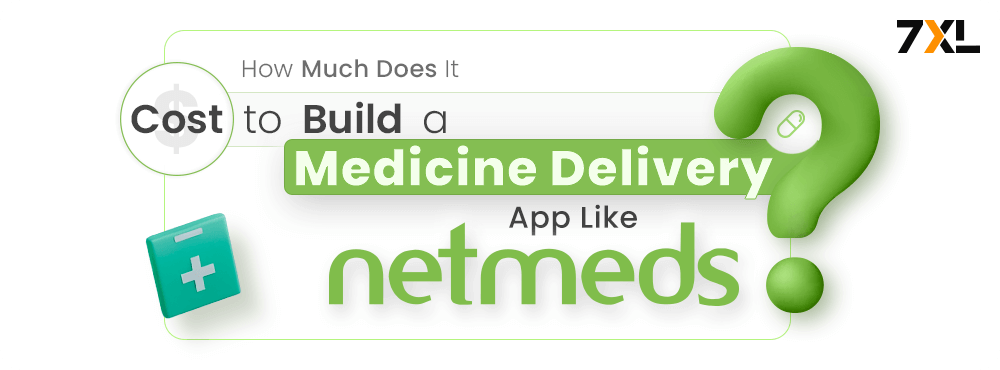
The emergence of digital healthcare solutions has revolutionized medicine delivery, with apps like NetMeds leading the charge. For businesses aiming to create a similar app, understanding the development costs is crucial.
These expenses are influenced by various factors, from essential features and backend infrastructure to regulatory compliance and ongoing maintenance. This guide breaks down the key elements that impact the cost of building a medicine delivery app like NetMeds, providing a comprehensive overview to help you plan your budget effectively.
Key Cost Factors for Developing a Medicine Delivery App Like NetMeds
Developing a medicine delivery app involves various components, each contributing to the overall cost. Here’s a detailed breakdown of the key cost factors:

1. App Features and Functionalities
The complexity and number of features significantly influence the cost. Essential features for a medicine delivery app like NetMeds include:
| Feature | Description | Estimated Cost |
| User Registration | Secure sign-up with email, social media, or phone number authentication | $1,500 – $3,000 |
| Medicine Search | Advanced search with filters like brand, category, and price | $2,000 – $4,000 |
| Expert Counseling | Consultations with medical professionals via chat or video | $3,000 – $5,000 |
| Trending Fitness Meals | Information on fitness meals and health tips | $2,000 – $3,500 |
| My Order Section | View order history, track orders, and reorder | $2,500 – $4,500 |
| Track Order | Real-time order tracking with GPS | $2,500 – $5,000 |
| Return Policy | Manage return requests and provide refund options | $1,500 – $3,000 |
| Loyalty Points | Reward points for customer loyalty | $2,000 – $4,000 |
| Managing Information | Update personal details and addresses | $1,500 – $3,000 |
| Ratings and Reviews | User feedback on products and services | $1,500 – $3,000 |
| Delivery and Shipment | Multiple delivery options and tracking | $2,500 – $5,000 |
| Discount Management | Create and manage discounts and promo codes | $2,000 – $4,000 |
| Managing Products | Admin control for product updates and inventory management | $3,000 – $6,000 |
| Affiliate Marketing | Promote products through affiliate partnerships | $2,000 – $4,000 |
| Refined Search | Advanced search functionalities like voice search | $2,500 – $5,000 |
| Upload Prescriptions | Secure prescription upload and verification | $1,800 – $3,500 |
| Associate Medical Store | Integration with local stores for product availability and quick deliveries | $3,000 – $6,000 |
Total Estimated Cost for Comprehensive Features: $38,800 – $80,500
2. Platform Choice
Choosing between iOS, Android, or a cross-platform approach impacts costs. Here’s a quick comparison:
| Platform | Description | Estimated Cost |
| iOS | Focused development for iOS users with potentially higher engagement | $10,000 – $25,000 |
| Android | Broader reach with diverse devices and operating systems | $10,000 – $25,000 |
| Cross-Platform | Develop for both iOS and Android simultaneously | $20,000 – $50,000 |
3. Backend Infrastructure and APIs
A robust backend is essential for handling user data, processing orders, and integrating with third-party services. Common API integrations include payment gateways, geolocation services, and analytics.
| Component | Description | Estimated Cost |
| Backend Development | Manages data storage, user authentication, and server-side logic | $10,000 – $20,000 |
| Payment Gateway Integration | Secure transactions with multiple payment options | $2,500 – $5,000 |
| Geolocation Services | Real-time tracking and location-based services | $1,500 – $3,000 |
| Analytics Integration | Monitor app usage and user behavior | $1,200 – $2,500 |
Total Estimated Cost for Backend and APIs: $15,200 – $30,500
4. Design and User Experience (UX)
Investing in a user-friendly design enhances engagement and retention. The cost varies based on complexity and customization.
| Design Type | Description | Estimated Cost |
| Basic Design | Simple and functional, suitable for MVPs | $3,000 – $6,000 |
| Custom Design | Tailored design with unique elements and animations | $6,000 – $12,000 |
5. Development Team
The cost to hire a development team depends mostly on their location, expertise, and hourly rates. Key roles include project managers, UI/UX designers, developers, and QA engineers.
| Role | Description | Estimated Cost |
| Project Manager | Oversees the project and coordinates the team | $50 – $120 per hour |
| UI/UX Designer | Designs user interface and experience | $40 – $100 per hour |
| Developers | Frontend, backend, and mobile developers | $60 – $150 per hour |
| QA Engineer | Tests the app for bugs and ensures quality | $40 – $100 per hour |
Total Estimated Cost for Development Team: $50,000 – $200,000 (depending on team size and location)
6. Maintenance and Updates
Post-launch maintenance and regular updates are crucial for app performance and user satisfaction.
| Maintenance Type | Description | Estimated Cost |
| Monthly Maintenance | Regular updates, bug fixes, and new features | $1,000 – $2,000 per month |
Annual Maintenance Cost: $12,000 – $24,000
Note: However, always remember that these are just the ballpark value of the features; the cost might differ when you choose the tech stack depending on the developers experience.
Factors Affecting the Cost of Building a Medicine Delivery App like NetMeds
Building a medicine delivery app like NetMeds involves multiple components, each contributing to the overall development cost. Understanding these factors is important for effective budgeting and project planning.
Partnering with a specialized Medicine Delivery App Development Company can help you build a comprehensive and efficient platform. They bring expertise in navigating regulatory requirements, integrating essential features like real-time tracking and secure payment options, and ensuring a seamless user experience. Below are the key factors that affect the cost of developing a medicine delivery app:
1. App Features and Complexity
The number & complexness of features significantly influence the cost of app development. Basic apps with limited functionalities will cost less compared to advanced apps with multiple features.
Key Factors:
- Essential Features: Basic functionalities like user registration, medicine search, and order tracking.
- Advanced Features: Features such as expert counseling, real-time order tracking, loyalty points, and prescription uploads.
- Customization: Custom features tailored to specific business needs increase development time and cost.
Estimated Cost Impact:
$38,800 – $80,500
2. Platform Choice
Choosing the right platform—iOS, Android, or both—affects the development cost. Developing for a single platform is less expensive than developing for multiple platforms.
Key Factors:
- Single Platform: Lower cost but limited to either iOS or Android users.
- Cross-Platform: Higher initial cost but broader user reach and potential savings in the long run.
Estimated Cost Impact:
- iOS or Android: $10,000 – $25,000
- Both Platforms: $20,000 – $50,000
3. Design and User Experience (UX)
A well-designed user interface and experience enhance user engagement and retention. The complexity of the design and the level of customization play a significant role in determining the cost.
Key Factors:
- Basic Design: Functional design suitable for MVPs with minimal customization.
- Custom Design: Tailored design with unique elements, animations, and a cohesive visual identity.
Estimated Cost Impact:
$3,000 – $12,000
4. Backend Infrastructure and API Integrations
A robust backend infrastructure is essential for managing data, processing transactions, and integrating third-party services. The complexity of the backend system and the number of API integrations impact the overall cost.
Key Factors:
- Data Management: Secure handling of user data, order details, and inventory.
- Third-Party APIs: Integration with payment gateways, geolocation services, and analytics tools.
Estimated Cost Impact:
$15,200 – $30,500
5. Development Team
The expertise, experience, and location of the development team influence the cost of building the app. Hiring experienced professionals in regions with higher labor costs can increase the overall expense.
Key Factors:
- Team Composition: Includes project managers, developers, UI/UX designers, and QA engineers.
- Location: Costs can change significantly based on the geographical location of the team (e.g., North America vs. Asia).
Estimated Cost Impact:
$50,000 – $200,000
6. Testing and Quality Assurance (QA)
Comprehensive testing and QA are essential to ensure the app functions correctly and meets quality standards. The cost depends on the extent of testing required and the complexity of the app.
Key Factors:
- Automated Testing: Tools for continuous integration and testing to identify bugs early.
- Manual Testing: Ensuring usability, performance, and security through thorough testing processes.
Estimated Cost Impact:
$5,000 – $15,000
7. Compliance and Security
Ensuring compliance with healthcare regulations and implementing robust security measures are paramount for the success of a medicine delivery app. Remember, having a non-compliance app can lead to legal issues & penalties.
Key Factors:
- Regulatory Compliance: Adhering to healthcare standards like HIPAA or GDPR.
- Security Measures: Encryption, secure data storage, and protection against cyber threats.
Estimated Cost Impact:
$5,000 – $10,000
8. Maintenance and Updates
Continuous maintenance & regular updates are crucial to keep the app functional and secure. The cost can differ based on the app complexity & update frequency is required.
Key Factors:
- Bug Fixes: Regular fixes to maintain app performance and user satisfaction.
- Feature Enhancements: Adding new features and improvements based on user feedback.
- Security Updates: Ensuring the app is protected against the latest threats.
Estimated Cost Impact:
$12,000 – $24,000 per year
9. Marketing and Promotion
Effective marketing & promotion are necessary to attract users and achieve app success. The budget for marketing activities can vary widely depending on the strategies and channels used.
Key Factors:
- Launch Campaign: Initial promotion to create awareness and drive downloads.
- Ongoing Marketing: Continuous efforts to retain users and increase engagement.
Estimated Cost Impact:
$5,000 – $30,000
10. Localization and Internationalization
If you plan to launch your app in multiple regions, localization and internationalization are crucial. This involves translating the app content and adapting it to different cultures and regulations.
Key Factors:
- Language Support: Translation of app content and user interface.
- Regional Compliance: Adapting to local regulations and healthcare standards.
Estimated Cost Impact:
$5,000 – $15,000
Summary Table of Cost Factors
| Cost Factor | Description | Estimated Cost Impact |
| App Features and Complexity | Essential and advanced features | $38,800 – $80,500 |
| Platform Choice | iOS, Android, or both platforms | $10,000 – $50,000 |
| Design and UX | Basic or custom design | $3,000 – $12,000 |
| Backend Infrastructure and APIs | Data management and third-party integrations | $15,200 – $30,500 |
| Development Team | Team expertise and location | $50,000 – $200,000 |
| Testing and QA | Automated and manual testing | $5,000 – $15,000 |
| Compliance and Security | Regulatory compliance and security measures | $5,000 – $10,000 |
| Maintenance and Updates | Ongoing maintenance and regular updates | $12,000 – $24,000 per year |
| Marketing and Promotion | Initial launch and ongoing marketing | $5,000 – $30,000 |
| Localization and Internationalization | Adapting app for different regions and languages | $5,000 – $15,000 |
Ways to Reduce the Cost of Building a Medicine Delivery App Like NetMeds
Building a medicine delivery app like NetMeds can be a notable investment, but there are various strategies you can apply to reduce the overall development costs without compromising on quality. Here are some effective ways to manage and lower the expenses involved:
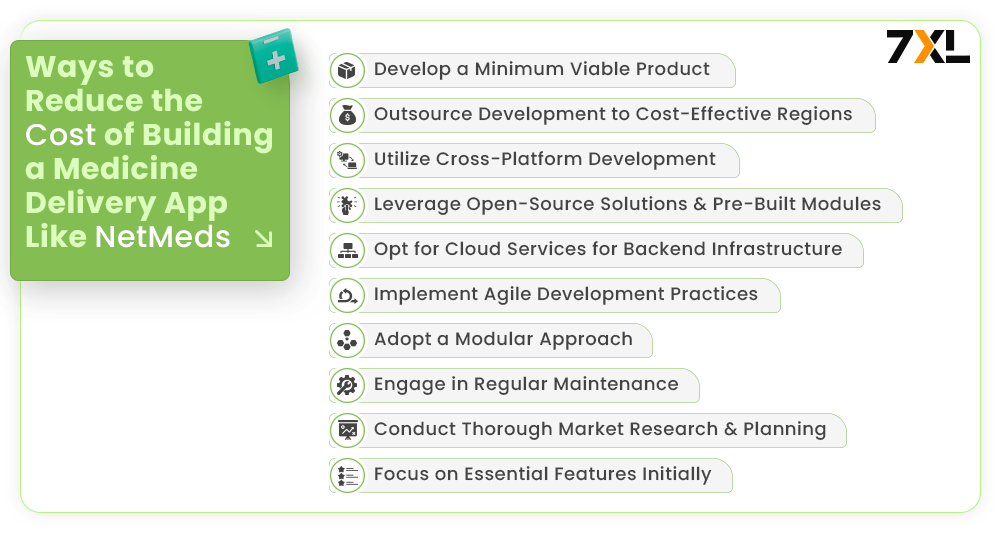
1. Develop a Minimum Viable Product (MVP)
Starting with an MVP allows you to launch the app with essential features and gather user feedback before investing in advanced functionalities. This approach helps in identifying what works and what needs improvement, minimizing the risk of over-investment in unnecessary features.
Key Strategies:
- Focus on Core Features: Include only the most critical features like user registration, medicine search, order management, and payment integration.
- Iterative Development: Build additional features based on user feedback and demand.
Cost Reduction Impact:
- Reduces initial development costs by 40% to 60%.
- Provides a quicker time-to-market.
2. Outsource Development to Cost-Effective Regions
Outsourcing your app development to regions with lower labor costs can significantly reduce expenses. Countries in Asia, Eastern Europe, & Latin America offer high-quality services at competitive rates.
Key Strategies:
- Select Experienced Teams: Choose development teams with proven expertise in app development and a strong portfolio.
- Consider Time Zones: Ensure that the time zone differences are manageable to facilitate smooth communication and project management.
Cost Reduction Impact:
Can lower development costs by up to 50% compared to hiring local developers in high-cost regions like North America or Western Europe.
3. Utilize Cross-Platform Development
Cross-platform development tools including React Native or Flutter helps you to develop a single codebase that functions on both iOS & Android, saving time and resources compared to developing separate native apps.
Key Strategies:
- Use Cross-Platform Frameworks: Leverage frameworks that support code reuse and reduce development time.
- Optimize Performance: Ensure the app performs well on both platforms by testing thoroughly.
Cost Reduction Impact:
- Reduces development time and costs by 30% to 40%.
- Simplifies maintenance & updates with a single codebase.
4. Leverage Open-Source Solutions and Pre-Built Modules
Using open-source libraries and pre-built modules for common functionalities can save significant development time and costs. These resources provide reliable solutions that can be easily integrated into your app.
Key Strategies:
- Identify Reusable Components: Use open-source libraries for features like user authentication, payment processing, and geolocation.
- Ensure Compatibility: Verify that the open-source components are compatible with your app’s architecture.
Cost Reduction Impact:
- Saves up to 20% of development costs by avoiding the need to build features from scratch.
- Reduces development time and accelerates the launch.
5. Opt for Cloud Services for Backend Infrastructure
Utilizing cloud services for hosting and backend infrastructure can remove the need for expensive hardware and reduce maintenance costs. Cloud platforms offer scalable solutions that can grow with your app.
Key Strategies:
- Choose Cloud Providers: Use services like AWS, Google Cloud, or Azure for flexible and cost-effective backend solutions.
- Scale as Needed: Start with minimal resources and scale up based on user demand and app growth.
Cost Reduction Impact:
- Cuts upfront infrastructure costs by up to 50%.
- Provides scalability and reduces ongoing maintenance expenses.
6. Implement Agile Development Practices
Agile development focuses on iterative progress, flexibility, and collaboration. This approach allows you to develop the app in small, manageable parts, making it easier to control costs and make adjustments based on real-time feedback.
Key Strategies:
- Break Down Projects: Divide the development process into smaller sprints with specific deliverables.
- Regular Updates: Provide frequent updates and prototypes to gather feedback and make necessary adjustments.
Cost Reduction Impact:
- Increases efficiency and reduces time-to-market by 30% to 40%.
- Helps in prioritizing features and avoiding unnecessary expenses.
7. Adopt a Modular Approach
Developing the app in a modular fashion allows for easier updates and maintenance. Modules can be developed independently, enabling you to add new features or make changes without disturbing the entire app.
Key Strategies:
- Create Independent Modules: Develop features like user authentication, order management, and payment processing as separate modules.
- Enhance Flexibility: Make it easier to scale and integrate new features in the future.
Cost Reduction Impact:
- Simplifies development and maintenance, saving up to 20% in costs.
- Facilitates easier and more cost-effective updates.
8. Engage in Regular Maintenance
Regular maintenance helps in identifying and fixing issues before they become major problems, reducing the need for costly overhauls and ensuring the app remains functional and secure.
Key Strategies:
- Schedule Maintenance: Plan regular maintenance sessions to keep the app up-to-date and running smoothly.
- Monitor Performance: Use analytics tools to monitor app performance and user behavior for proactive maintenance.
Cost Reduction Impact:
- Prevents costly repairs and updates, saving up to 15% in long-term maintenance costs.
- Enhances app performance and user satisfaction.
9. Conduct Thorough Market Research & Planning
Conducting comprehensive market research helps you understand user needs and identify potential competitors, allowing you to build a focused and effective app. Proper planning can avoid unnecessary features and expenses.
Key Strategies:
- Identify User Needs: It is important to concentrate on the elements that your target audience finds most valuable.
- Competitive Analysis: Understand what competitors offer and identify gaps in the market.
Cost Reduction Impact:
- Helps avoid costly missteps and unnecessary features, reducing development costs by up to 20%.
- Ensures that investments are aligned with market demand and user expectations.
10. Focus on Essential Features Initially
Prioritize developing core functionalities that are critical to the app’s operation and user satisfaction. Later on, more features can be added in response to customer demand and input.
Key Strategies:
- Identify Core Features: Focus on must-have features like user registration, order management, and payment integration.
- Add Features Gradually: Implement advanced features in phases after the initial launch.
Cost Reduction Impact:
- Reduces initial development costs by 40% to 60%.
- Allows for a quicker launch and subsequent feature enhancements.
How Can 7xcel Help You Build a Medicine Delivery App Like NetMeds?
At 7xcel, we specialize in developing customized medicine delivery apps that meet your specific needs.

Our group of scholarly project managers, developers, and designers collaborate to make sure your software not only satisfies user needs but also meets industry standards. We provide solutions that promote customer happiness and business progress with an emphasis on innovation, security, and user experience.
Conclusion
Building a medicine delivery app like NetMeds requires careful planning, a clear understanding of market needs, and strategic investment in technology and design. By considering the factors and cost-saving strategies outlined in this guide, entrepreneurs and healthcare professionals can embark on creating a successful and cost-effective app that meets the demands of today’s digital-savvy consumers. Ready to take the first step? Contact 7xcel today and let’s turn your vision into reality.
